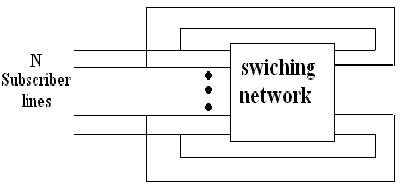Explain differences between folded and non-folded network.
Folded network: While all the inlets/outlets are connected to the subscriber lines, the logical connection shows as demonstrated in figure. When, the output lines are folded back to the input and therefore the network is termed as a folded network. Four kinds of connection may be established:
1. Local call connection among two subscribers in the system.
2. Outgoing call connection among a subscriber and an outgoing trunk.
3. Incoming call connection among an incoming trunk and a local subscriber.
4. Transit calls connection among an incoming trunk and an outgoing trunk.
In a folded network along with N subscriber, there can be a maximum of N/2 information interchanges or simultaneous calls.

FIG - Folded Network
Non-Folded Network: In a switching network, every inlet/outlet connection may be utilized for inter exchange transmission. In this case, the exchange does not assist local subscribers and is termed as a transit exchange. A switching network of this type is demonstrated in figure and is termed as a non-folded network. In non-folded network along with N inlets and N outlets, N simultaneous information transfers are possible. Therefore, for a non-folded network to be non-blocking, the network must support N simultaneous switching paths.

FIG - Non-Folded Network